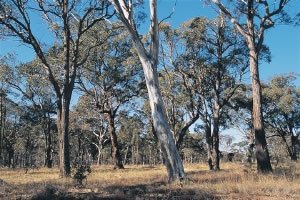New England Grassy Woodlands
Vegetation Class
Credits awarded for conservation and regeneration of Threatened Ecological Communities in this Vegetation Class are currently in high demand by large development projects in NSW. See below on how to identify this Vegetation Class on your property and actions required to generate credits.
Identification
New England Grassy Woodlands can be identified by their open eucalypt woodlands. These woodlands can reach about 25 meters tall on fertile soils or a bit shorter, around 20 meters, on drier soils found on hills and slopes. The ground cover is mostly grassy, but it may not be as continuous as in other similar woodlands.
When you're looking at New England Grassy Woodlands, you'll notice that there aren't many upright shrubs. However, if you look closely, you might find some small shrubs that grow low to the ground and are partially hidden among the grass.
The dominant trees in this vegetation class include rough-barked apple, Blakely's red gum, apple box, broad-leaved stringybark, silver-top stringybark, yellow box, and Youmans stringybark. In flatter areas and open valleys, you'll often find New England peppermint as the main tree species.
Other plants you might come across in these woodlands are blackthorn, dogwood, peach heath, rice flower, and native raspberry, among others.
To identify New England Grassy Woodlands, look for relatively fertile soils derived from low-quartz sedimentary or granitic substrates. These woodlands are usually found at elevations above 600 meters on rolling tablelands. The average annual precipitation in these areas ranges from 550 to 850 millimeters, including both rain and occasional snowfall.
You'll mostly find these woodlands on the New England tableland, from Bendemeer and Walcha in the south to Stanthorpe, just over the Queensland border. Keep in mind that the composition of plants may vary depending on the type of soil and the landscape.
These woodlands have been extensively cleared for farming, and some tree species are facing decline due to rural dieback. So, if you come across areas that match these descriptions, you're likely looking at New England Grassy Woodlands.
Location
Restricted to New England tableland, north from Bendemeer and Walcha on the southern New England tableland to Stanthorpe just over the Queensland border. Examples occur on the lower slopes of Mount Duval and in Imbota Nature Reserve.
Estimated percentage landcover for vegetation class
Green: <1%
Purple: 1-10%
Blue: 10-50%
Red: >50%
Credit Generation
To generate credits, landholders need to implement specific management actions. These actions aim to conserve and regenerate the ecological communities on their property. Here are the key management actions you would need to take:
Vegetation conservation: Protect existing remnant vegetation of New England Grassy Woodlands on your property from clearing or degradation. This includes preventing further loss of trees and ensuring the integrity of the vegetation structure.
Invasive species control: Implement measures to control and manage invasive plant species within the New England Grassy Woodlands. This involves identifying and targeting invasive plants that threaten the native flora and actively removing or controlling them.
Grazing management: Optimize grazing practices to reduce the negative impacts on the New England Grassy Woodlands. Adjust stocking rates, implement rotational grazing systems, and avoid overgrazing that can lead to soil erosion and loss of native plant diversity.
Weed control: Undertake weed control activities specifically targeted at invasive plant species that compete with native vegetation within the New England Grassy Woodlands. Use appropriate methods such as selective herbicide application or manual removal to minimize damage to native plants.
Regeneration and restoration: Where New England Grassy Woodlands remnants have been degraded or lost, actively restore and regenerate the native vegetation. This may involve planting native trees, shrubs, and grasses, and ensuring their ongoing care and maintenance.
Habitat protection: Pay attention to the conservation of habitat features crucial for supporting wildlife within the New England Grassy Woodlands. This includes preserving fallen timber, providing habitat for nesting or roosting birds, and maintaining diverse vegetation layers.
Monitoring and reporting: Regularly monitor the condition of the New England Grassy Woodlands on your property and document the outcomes of your management actions. This monitoring helps track the progress of conservation efforts and ensures compliance with the requirements of the Biodiversity Offset Scheme.
By implementing these management actions, you will contribute to the conservation and restoration of the New England Grassy Woodlands. These actions will help generate biodiversity credits, which can be traded to offset biodiversity impacts from developments and provide financial incentives to support the ongoing management of the ecological community on your farm.


